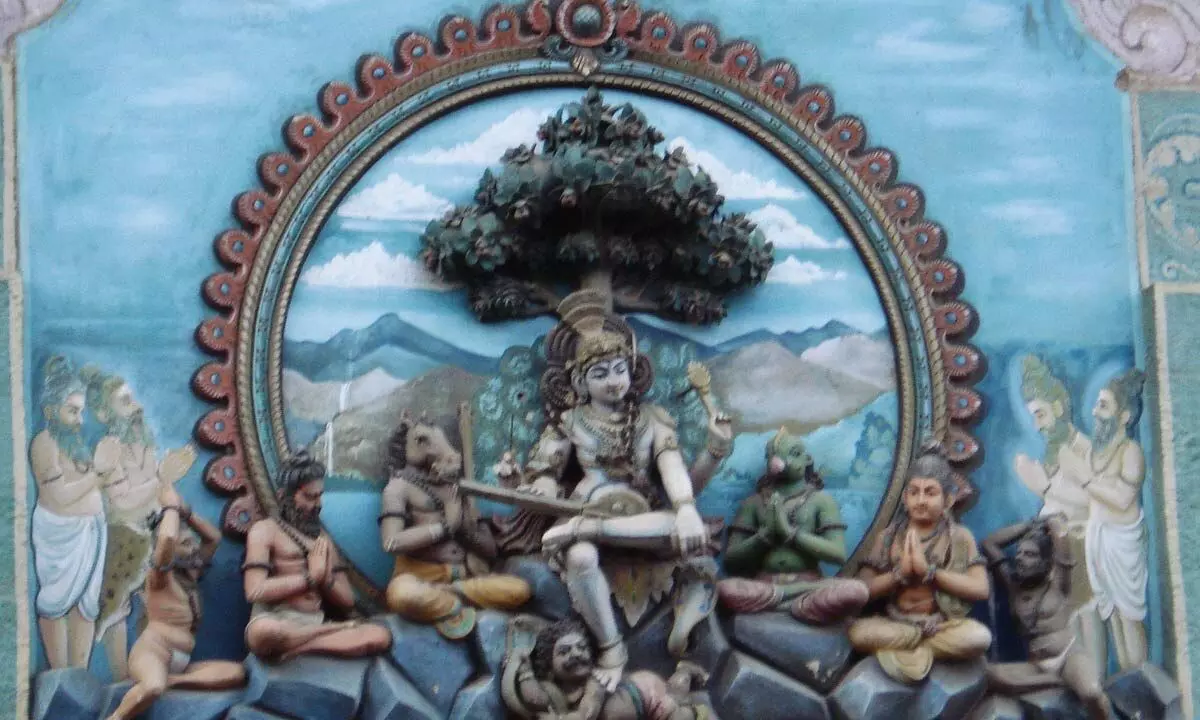Live
- Japanese government approves 250-billion USD economic package to ease price pain
- Six pharma companies to set up their units in Telangana
- The Unstable Events of a 17-Wicket Day in Perth: India vs Australia
- Dutch FM's Israel trip cancelled after Netanyahu's arrest warrant
- UK to increase energy price cap by 1.2 per cent
- Ethiopia launches national coffee platform to maximise earnings
- Centre completes auction of 3 coal blocks, to yield annual revenue of Rs 2,710 crore
- Ullal Woman Files Complaint Against Husband Over Instant Talaq and Abuse
- Analysis: Russia's Nuclear-Capable Missile Marks Shift from Cold War Deterrence Doctrine
- OpenAI Plans In-House Browser "SearchGPT" to Compete with Google Chrome
Just In
Threads of silence: Sign language, an ancient legacy


Exploring the enduring legacy of sign language and its profound connections to ancient Bharat and Hindu iconography
Sign language has a profound connection to ancient Bharat, deeply embedded in its culture and still vibrantly alive today. Its significance can be seen in the rich artistic heritage of classical Bharat dance forms like Bharatanatyam and Odissi, where intricate hand gestures, known as mudras, carry specific meanings and form complex vocabulary. The Natya Shastra (an ancient Indian treatise on dramaturgy) mentions gestures as key forms of communication.
However, formal education led to the marginalization of sign language in India, leaving it for especially abled with limited access to communication and education. Sign language is a powerful tool in bridging the communication gap between individuals who may not share a common spoken language. It shares a core foundation of visual components like hand gestures, facial expressions, and body language, allowing individuals from diverse backgrounds to grasp basic concepts and intentions. Basic human needs and emotions remain universal, and sign language can establish a level of understanding that transcends spoken words, fostering empathy and basic communication. Sign languages are not static entities, evolving and adapting over time, incorporating elements from other sign languages or spoken languages. This adaptability allows users to communicate effectively even if their sign language dialects differ slightly.
Nonverbal cues, such as facial expressions and body language, are also important in sign language, as they allow for a deeper understanding of intent and meaning beyond the literal signs used. While sign language may not always enable complex conversations between complete strangers, it acts as a crucial bridge, fostering understanding, building connections, and ultimately promoting inclusion in a diverse world. For instance, the magical communication of a mother and child is associated with facial expressions. The child understands and learns things through sign language effectively. In our culture, some key moments are expressed in relationships through silent communication.
Hinduism is a multifaceted religion with deities playing a central role. Images of Hindu gods are not just beautiful works of art but intricate visual narratives designed to communicate spiritual concepts, philosophical ideas, and mythological stories. Each deity is associated with specific symbols and attributes that instantly convey their nature and power.
Vishnu, for example, is often depicted reclining on a serpent, holding a conch, discus, lotus, and mace, symbolizing cosmic preservation, divine sound, purity, and power. Shiva, with a trident, a drum, a crescent moon, and the sacred Ganges River flowing from his hair, signifies his role as destroyer, the rhythm of creation, time, and purification. Ganesha, the beloved elephant-headed god, is associated with wisdom, overcoming obstacles, and good fortune. The everlasting image of Dakshinamurthy is self-explanatory; it’s the illustration to understand silent communication. Lord Shiva in a meditative posture and the four disciples looking at him. He is depicted in the sitting posture under a tree in Gyana mudra. Mudras (hand gestures) hold significant meaning, with each having a specific symbolic value. Abhaya mudra, raised in blessing, signifies protection and fearlessness, while Varada mudra, extended downwards in offering, represents compassion and wish-fulfillment.
The rich imagery associated with Hindu gods allows them to communicate in ways that transcend written or spoken language. These images inspire devotion, teach values, and create a sense of community among Hindu followers. Thus, Hindu gods serve as a powerful form of communication, conveying complex theological and philosophical concepts in a visually engaging and accessible way. Temple iconography is not a living entity, but its interpretation and meaning can evolve over time. Historical context, reinterpretation, and new discoveries can all contribute to the evolution of meaning. For instance, the original meaning of certain iconographic elements may fade or change due to historical shifts, cultural changes, and the loss of direct oral traditions. Different generations and cultures may reinterpret the meaning based on their own beliefs and understanding, influenced by contemporary social and cultural contexts. Archaeological research and historical analysis can sometimes uncover new discoveries about the original purpose and symbolism of specific elements in temple iconography, reviving forgotten meanings and revealing the communication intended by the creators.
Communication through interpretation involves storytelling and oral traditions, with temple priests, scholars, and storytellers playing a key role in shaping how people understand the symbolism and messages embedded in the imagery. Artistic innovation and modern technology can also enhance understanding and facilitate communication of complex meanings embedded within the visuals. Understanding temple iconography is often layered and subjective, with interpretations varying based on individual perspectives and cultural backgrounds. Despite this, through the dynamic interplay of historical context, reinterpretation, storytelling, artistic innovation, and modern technology, temple iconography continues to offer valuable insights into the past and communicate its messages to new audiences.

© 2024 Hyderabad Media House Limited/The Hans India. All rights reserved. Powered by hocalwire.com






